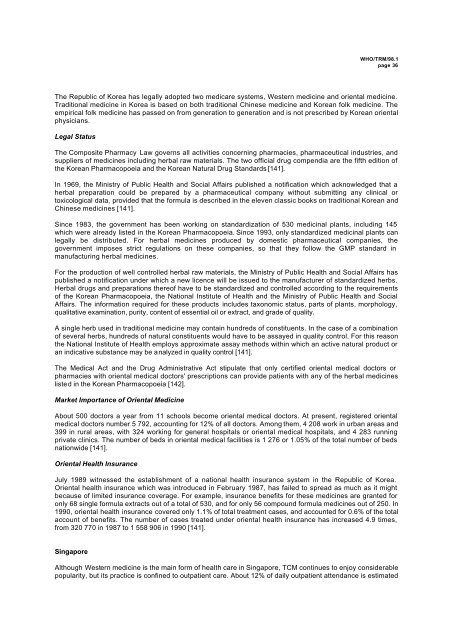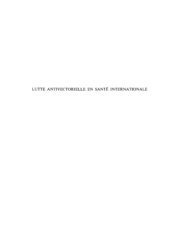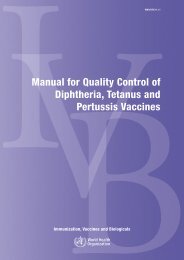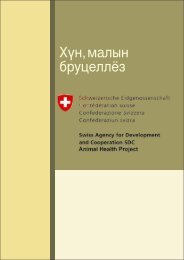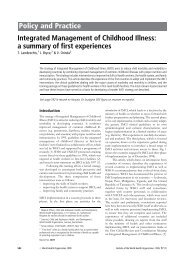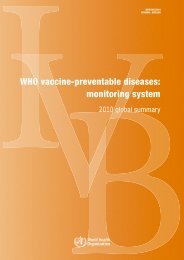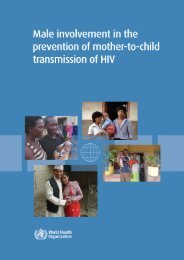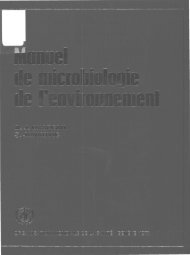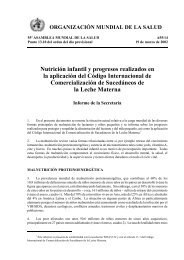Regulatory Situation of Herbal Medicines A worldwide Review
Regulatory Situation of Herbal Medicines A worldwide Review
Regulatory Situation of Herbal Medicines A worldwide Review
Create successful ePaper yourself
Turn your PDF publications into a flip-book with our unique Google optimized e-Paper software.
WHO/TRM/98.1page 36The Republic <strong>of</strong> Korea has legally adopted two medicare systems, Western medicine and oriental medicine.Traditional medicine in Korea is based on both traditional Chinese medicine and Korean folk medicine. Theempirical folk medicine has passed on from generation to generation and is not prescribed by Korean orientalphysicians.Legal StatusThe Composite Pharmacy Law governs all activities concerning pharmacies, pharmaceutical industries, andsuppliers <strong>of</strong> medicines including herbal raw materials. The two <strong>of</strong>ficial drug compendia are the fifth edition <strong>of</strong>the Korean Pharmacopoeia and the Korean Natural Drug Standards [141].In 1969, the Ministry <strong>of</strong> Public Health and Social Affairs published a notification which acknowledged that aherbal preparation could be prepared by a pharmaceutical company without submitting any clinical ortoxicological data, provided that the formula is described in the eleven classic books on traditional Korean andChinese medicines [141].Since 1983, the government has been working on standardization <strong>of</strong> 530 medicinal plants, including 145which were already listed in the Korean Pharmacopoeia. Since 1993, only standardized medicinal plants canlegally be distributed. For herbal medicines produced by domestic pharmaceutical companies, thegovernment imposes strict regulations on these companies, so that they follow the GMP standard inmanufacturing herbal medicines.For the production <strong>of</strong> well controlled herbal raw materials, the Ministry <strong>of</strong> Public Health and Social Affairs haspublished a notification under which a new licence will be issued to the manufacturer <strong>of</strong> standardized herbs.<strong>Herbal</strong> drugs and preparations there<strong>of</strong> have to be standardized and controlled according to the requirements<strong>of</strong> the Korean Pharmacopoeia, the National Institute <strong>of</strong> Health and the Ministry <strong>of</strong> Public Health and SocialAffairs. The information required for these products includes taxonomic status, parts <strong>of</strong> plants, morphology,qualitative examination, purity, content <strong>of</strong> essential oil or extract, and grade <strong>of</strong> quality.A single herb used in traditional medicine may contain hundreds <strong>of</strong> constituents. In the case <strong>of</strong> a combination<strong>of</strong> several herbs, hundreds <strong>of</strong> natural constituents would have to be assayed in quality control. For this reasonthe National Institute <strong>of</strong> Health employs approximate assay methods within which an active natural product oran indicative substance may be analyzed in quality control [141].The Medical Act and the Drug Administrative Act stipulate that only certified oriental medical doctors orpharmacies with oriental medical doctors' prescriptions can provide patients with any <strong>of</strong> the herbal medicineslisted in the Korean Pharmacopoeia [142].Market Importance <strong>of</strong> Oriental MedicineAbout 500 doctors a year from 11 schools become oriental medical doctors. At present, registered orientalmedical doctors number 5 792, accounting for 12% <strong>of</strong> all doctors. Among them, 4 208 work in urban areas and399 in rural areas, with 324 working for general hospitals or oriental medical hospitals, and 4 283 runningprivate clinics. The number <strong>of</strong> beds in oriental medical facilities is 1 276 or 1.05% <strong>of</strong> the total number <strong>of</strong> bedsnationwide [141].Oriental Health InsuranceJuly 1989 witnessed the establishment <strong>of</strong> a national health insurance system in the Republic <strong>of</strong> Korea.Oriental health insurance which was introduced in February 1987, has failed to spread as much as it mightbecause <strong>of</strong> limited insurance coverage. For example, insurance benefits for these medicines are granted foronly 68 single formula extracts out <strong>of</strong> a total <strong>of</strong> 530, and for only 56 compound formula medicines out <strong>of</strong> 250. In1990, oriental health insurance covered only 1.1% <strong>of</strong> total treatment cases, and accounted for 0.6% <strong>of</strong> the totalaccount <strong>of</strong> benefits. The number <strong>of</strong> cases treated under oriental health insurance has increased 4.9 times,from 320 770 in 1987 to 1 558 906 in 1990 [141].SingaporeAlthough Western medicine is the main form <strong>of</strong> health care in Singapore, TCM continues to enjoy considerablepopularity, but its practice is confined to outpatient care. About 12% <strong>of</strong> daily outpatient attendance is estimated


